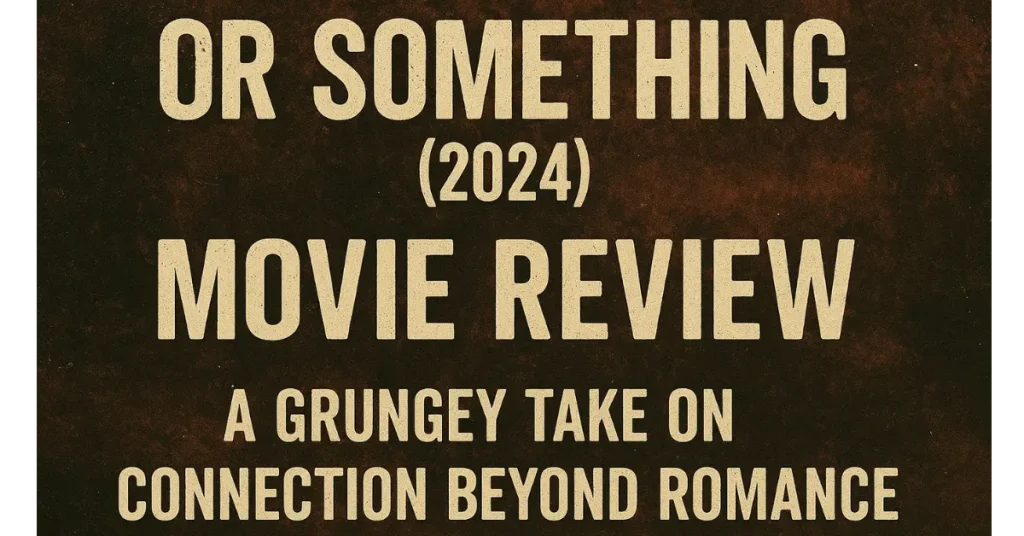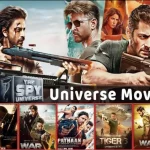In an era where romantic comedies often feel polished to perfection, “Or Something” emerges as a refreshingly unvarnished take on human connection. Jeffrey Scotti Schroeder’s directorial debut doesn’t offer the warm embrace of traditional romance films, instead presenting us with something far more complex and challenging. This indie drama starring Kareem Rahma and Mary Neely delivers a gritty exploration of modern relationships that feels both deeply personal and universally relatable.
The film follows two strangers who find themselves in the same Brooklyn apartment, both seeking money they’re owed from the same unreliable debtor. What begins as a simple debt collection mission transforms into an unexpected journey through New York City, forcing these unlikely companions to confront not only their circumstances but also their own vulnerabilities and preconceptions about connection in the modern world.
The Genesis of an Authentic NYC Story
The creation of “Or Something” represents a fascinating convergence of viral internet culture and traditional filmmaking. Mary Neely, who gained widespread attention during the COVID-19 pandemic through her viral recreations of Broadway musicals in her apartment, co-wrote the screenplay with Kareem Rahma, the creator behind the popular “Subway Takes” series. Their collaboration began when Rahma posted on Instagram expressing his desire to be cast in a serious film like Mathieu Kassovitz’s “La Haine,” prompting Neely to reach out with an offer to collaborate.
The film’s organic development process mirrors its authentic storytelling approach. As Neely explained, the project started when a tech worker who had seen her viral videos offered financial support for a creative project. Rather than rushing into production, Neely and Rahma spent time developing their characters through real conversations about their lives, with many of these discussions making their way into the final screenplay. This collaborative writing process helps explain why the dialogue feels so naturally conversational rather than scripted.
Characters That Defy Convention
Unlike the charming protagonists of Richard Linklater’s “Before Sunrise,” which serves as a clear inspiration for the film, Amir and Olivia don’t immediately win audience affection. Kareem Rahma’s Amir attempts to bridge conversational gaps with genuine curiosity, while Mary Neely’s Olivia maintains a protective distance that creates constant friction between the characters. This dynamic creates what feels like an anti-romance, where connection must be earned rather than assumed.
The film’s character development strategy deliberately challenges viewers’ expectations about likability. Where traditional romantic comedies might smooth over personality conflicts for the sake of narrative convenience, “Or Something” embraces the awkwardness and genuine difficulty of getting to know someone who operates from a fundamentally different worldview. Olivia’s guardedness and Amir’s persistent attempts at connection create a tension that feels authentic to real-world encounters between strangers.
This approach to character development reflects both writers’ backgrounds in engaging with diverse perspectives. Rahma’s experience hosting “Subway Takes,” where he engages with guests holding vastly different viewpoints, translates into Amir’s curiosity about Olivia’s perspectives. Similarly, Neely’s background in performance art during the pandemic, where she had to embody multiple characters simultaneously, informs Olivia’s complex emotional layers.
A Grungey Love Letter to New York City
Perhaps more than a character study, “Or Something” functions as an unvarnished portrait of New York City. The film’s 83-minute runtime takes viewers on a journey from Brooklyn to Harlem as the protagonists search for “Uptown Mike,” played by David Zayas. This cross-borough odyssey showcases the city’s diverse neighborhoods without the glossy treatment typical of big-budget New York films.
The cinematography by Jeff Leeds Cohn captures the city’s inherent franticness and gritty authenticity. Rather than presenting NYC as a romantic backdrop, the film embraces the city’s unforgiving nature. Characters bundle up in heavy coats against the cold, creating a tangible sense of the physical discomfort that accompanies urban exploration. This visual approach reinforces the film’s commitment to authenticity over idealization.
The choice to set the story during a single day of debt collection creates natural opportunities to explore different corners of the city. From Brooklyn apartments to Manhattan thrift stores to Harlem meeting spots, the film uses its locations not just as backdrops but as active participants in the story. Each location reflects different aspects of the characters’ journeys, both literal and metaphorical.
Themes of Identity and Modern Communication
Beyond its surface narrative about debt collection, “Or Something” explores deeper themes of identity, privilege, and the challenges of authentic communication in contemporary society. The film’s dialogue naturally incorporates discussions about gender dynamics, faith, and social privilege without feeling forced or didactic. These conversations emerge organically from the characters’ attempts to understand each other rather than from a desire to make explicit political statements.
The gender dynamics between Amir and Olivia receive particular attention, with the film exploring how men and women navigate conversations about attraction, safety, and personal boundaries. Rather than providing easy answers, the film allows these tensions to exist and evolve throughout their day together. This approach reflects the complexity of real-world gender relations without reducing them to simple talking points.
The film’s treatment of privilege operates on multiple levels, examining both economic inequality and social advantages. The debt collection premise immediately establishes economic precarity as a central concern, while the characters’ conversations reveal different perspectives on opportunity and systemic barriers. These discussions feel natural rather than preachy because they emerge from the characters’ lived experiences rather than external political agendas.
Performance and Direction
Jeffrey Scotti Schroeder’s direction maintains a careful balance between intimate character moments and broader social observation. His background in music videos and commercials translates into visual storytelling that never feels static despite the film’s dialogue-heavy structure. The direction allows for natural pauses and silences that give weight to both spoken words and unspoken tensions.
Kareem Rahma’s performance as Amir draws on his experience engaging with diverse perspectives through “Subway Takes”. His portrayal captures both genuine curiosity about others and the social awkwardness that comes with persistent questioning. Rahma’s ability to shift between agreement and disagreement, honed through his viral video series, serves the character’s complex relationship with Olivia.
Mary Neely brings depth to Olivia’s guardedness, creating a character who feels protective rather than simply unfriendly. Her performance suggests layers of experience and trauma without explicitly revealing them until strategically chosen moments. The chemistry between Rahma and Neely, developed through their collaborative writing process, creates believable friction that serves the story’s themes about the difficulty and necessity of human connection.
Production and Distribution
The film’s production represents a successful model for independent filmmaking in the digital age. With a budget supported by private investors who believed in the creators’ viral content success, “Or Something” demonstrates how online platforms can serve as launching pads for traditional media projects. The film’s 80-minute runtime and intimate scale reflect budget-conscious decisions that enhance rather than limit the storytelling.
The distribution strategy, beginning with theatrical runs at venues like The Quad Cinema in New York and Braindead Studios in Los Angeles, reflects a commitment to the theatrical experience despite the film’s modest scale. The film’s festival circuit success, including screenings with Q&A sessions featuring the stars and creators, builds community around independent cinema.
Critics have responded positively to the film’s authentic approach to character development and urban storytelling. Robert W. Monk of Flickering Myth praised the film as “thoroughly entertaining” and described it as playing “like a jazzy travelogue”. The New York Sun’s Carlos Sousa found the film “edgy but affable” and “gritty but almost whimsical”, capturing the delicate balance the film strikes between harsh realism and hopeful humanity.
Cultural Context and Relevance
“Or Something” arrives at a moment when audiences hunger for authentic representations of economic anxiety and social disconnection. The film’s premise of debt collection resonates with widespread concerns about financial precarity, while its exploration of urban isolation speaks to post-pandemic social dynamics. The characters’ struggles to connect authentically reflect broader cultural conversations about the quality of human relationships in an increasingly digital world.
The film’s connection to viral internet culture through its creators adds another layer of contemporary relevance. Both Rahma and Neely built their initial audiences through platforms that reward brief, engaging content, yet “Or Something” demonstrates their ability to sustain interest over a feature-length narrative. This transition from short-form to long-form content mirrors broader shifts in how creators develop and monetize their audiences.
The movie’s treatment of New York City as both setting and character reflects ongoing conversations about urban gentrification, economic inequality, and community survival. By focusing on characters navigating the city’s less glamorous realities, the film contributes to a tradition of authentic New York storytelling that includes works by independent filmmakers who prioritize lived experience over tourist-friendly imagery.
Technical Achievements and Style
The film’s technical approach prioritizes naturalism over visual flourish, creating an aesthetic that supports rather than distracts from the character development. Editor Pete Ohs shapes the material into a rhythmic flow that allows conversations to breathe while maintaining narrative momentum. The editing choices respect the actors’ performances by avoiding unnecessary cuts that might interrupt the natural development of their interactions.
The cinematography creates visual interest through location diversity rather than elaborate camera movements. The film’s journey structure provides natural opportunities for varied compositions and lighting conditions, from intimate apartment interiors to bustling street scenes to quiet restaurant conversations. This approach creates visual progression that mirrors the characters’ emotional journey without calling attention to itself.
The sound design and musical choices, supervised by composer Jilian Medford, enhance the urban atmosphere without overwhelming the dialogue-driven narrative. The film’s audio landscape includes authentic city sounds that ground the story in its specific geographic and cultural context, while musical choices support emotional moments without manipulating audience responses.
Comparisons to Genre Predecessors
While inevitable comparisons to “Before Sunrise” highlight the film’s conversational structure and urban walking sequences, “Or Something” distinguishes itself through its grittier tone and more challenging character dynamics. Where Linklater’s film presented idealized strangers discovering romantic connection, Schroeder’s work explores the messier realities of people who must overcome genuine incompatibilities to achieve even basic understanding.
The film also shares DNA with mumblecore classics that prioritize authentic dialogue and naturalistic performance over plot-driven storytelling. However, “Or Something” maintains stronger narrative structure through its debt collection premise, which provides clear goals and obstacles that drive character interaction. This balance between naturalistic dialogue and structured storytelling helps the film avoid the aimlessness that sometimes characterizes improvisational independent films.
Contemporary indie films like “Rye Lane” offer interesting points of comparison in their treatment of urban romance and cross-cultural connection. While both films use city exploration as a vehicle for character development, “Or Something” maintains a more pessimistic view of social dynamics that reflects current anxieties about economic inequality and social fragmentation.
Reception and Critical Response
The film has garnered positive reviews from critics who appreciate its authentic approach to character development and urban storytelling. Avi Offer of NYC Movie Guru found the performances “raw” and praised their ability to ground the film “in authenticity so that you’ll think you’re watching a documentary”. This documentary-like quality reflects the film’s commitment to naturalistic dialogue and unforced character interactions.
Stephen Saito of The Movable Fest described the film as “a charming urban adventure” with “provocative ideas and a quick wit”, highlighting the balance between entertainment value and intellectual engagement. The film’s ability to maintain audience interest while exploring challenging themes demonstrates successful integration of accessible storytelling with substantive content.
Tom O’Brien of The Next Best Picture noted the natural chemistry between Rahma and Neely, writing that their ease working together “creates a chemistry that you can’t buy”. This observation points to one of the film’s key strengths: the authentic relationship between the creators translates into believable on-screen dynamics that support the story’s themes about the possibility of genuine human connection.
Conclusion and Cultural Impact
“Or Something” succeeds as both entertainment and cultural commentary by refusing to simplify the complexities of modern urban relationships. The film’s commitment to authentic dialogue and challenging character dynamics creates a viewing experience that rewards patience and emotional engagement. Rather than providing easy answers about connection and communication, the movie explores the messy realities of trying to understand someone whose life experiences differ fundamentally from your own.
The film’s production model offers inspiration for other creators looking to transition from digital platforms to traditional media. By leveraging their online audiences and maintaining creative control through independent financing, Rahma and Neely demonstrate practical pathways for content creators seeking to expand their artistic reach. Their success suggests that authentic voice and genuine perspective can overcome limited budgets and industry access barriers.
For viewers seeking alternatives to conventional romantic comedies, “Or Something” provides a thoughtful exploration of human connection that acknowledges both the difficulty and necessity of reaching across social and personal boundaries. The film’s grungey authenticity and commitment to complex characterization mark it as a significant contribution to contemporary independent cinema that deserves attention from audiences hungry for genuine stories about modern relationships.
Whether you discover “Or Something” in theaters or through subsequent distribution, the film offers a rare combination of entertainment value and emotional honesty that lingers beyond its 83-minute runtime. In a cultural moment marked by division and disconnection, this small but ambitious film reminds us that understanding across difference remains both challenging and essential to human flourishing.


